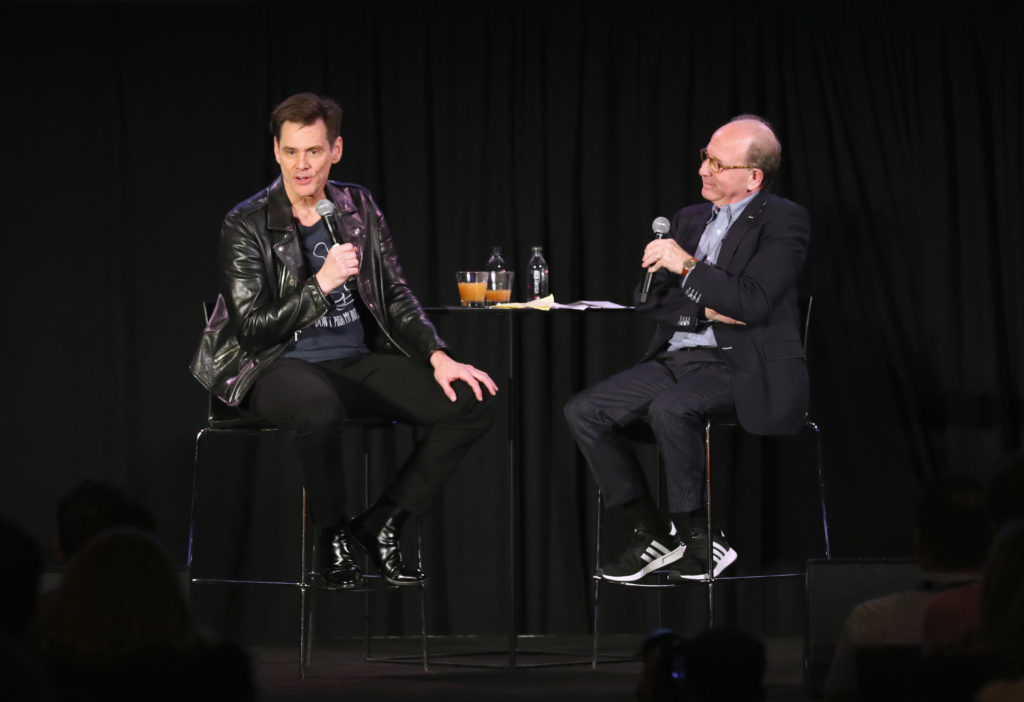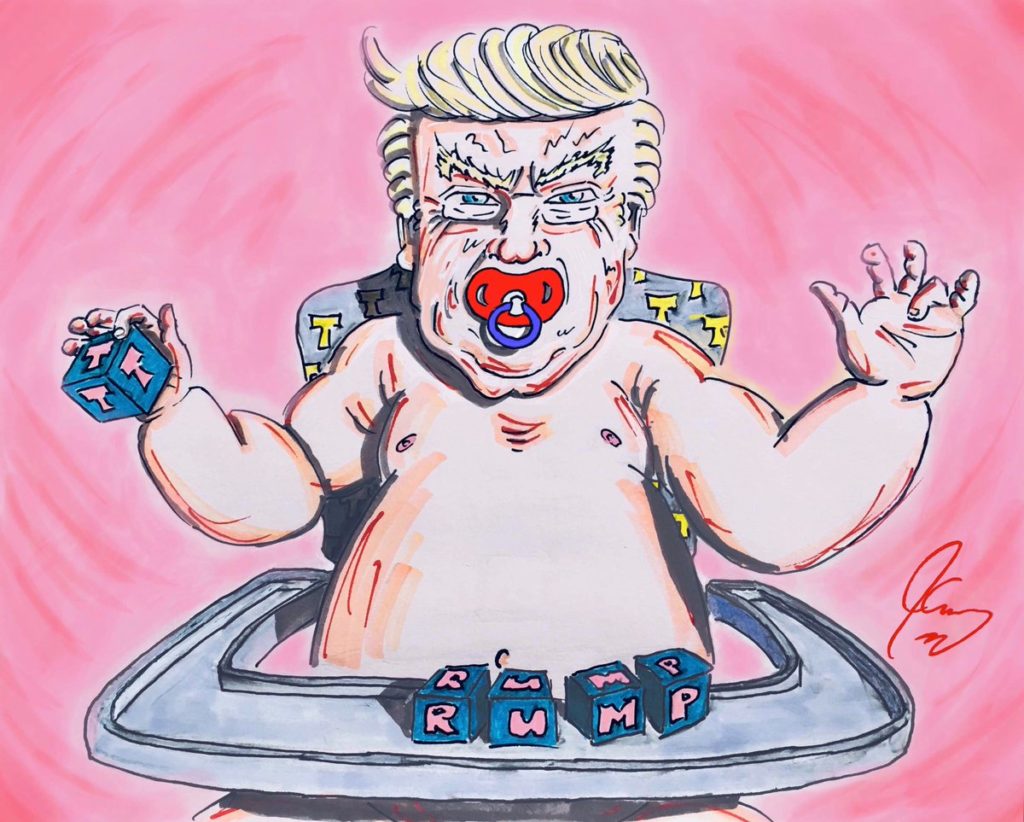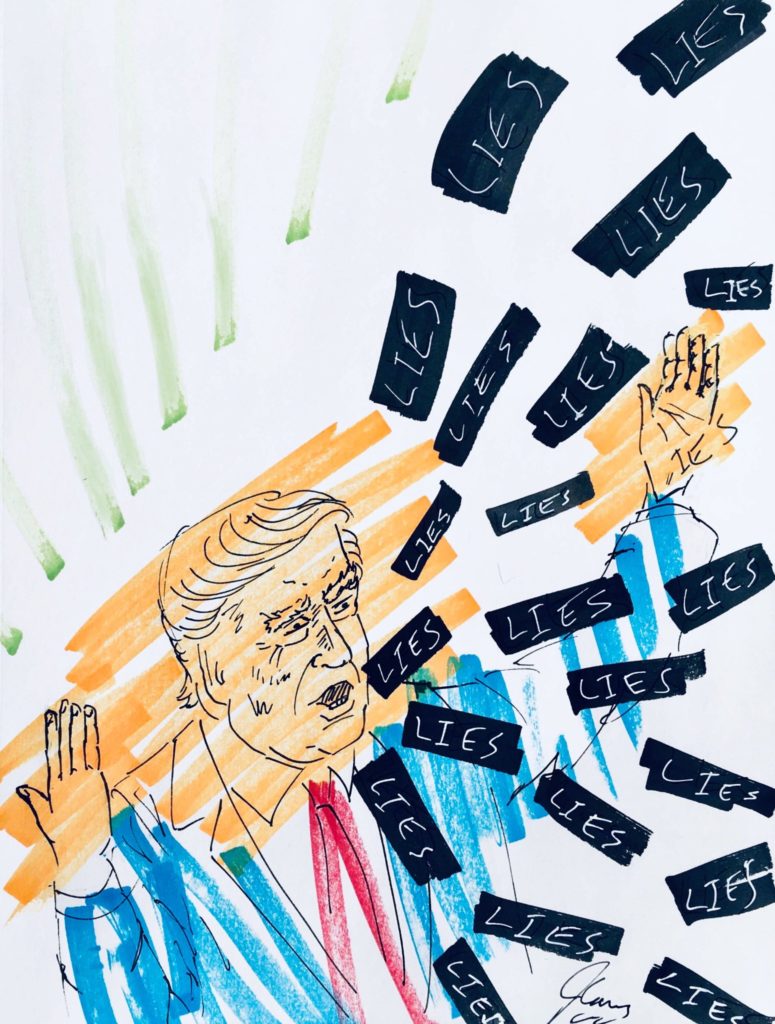Art World
Jim Carrey ‘Is Definitely an Artist,’ Jerry Saltz Says in a Freewheeling Conversation About How Political Rage Fuels Both of Their Work
The actor-turned-artist tweeted a new composition of Mitch McConnell as a turtle from the stage.

The actor-turned-artist tweeted a new composition of Mitch McConnell as a turtle from the stage.

Janelle Zara

“Social media is a canvas for me,” the actor Jim Carrey said on Sunday at Hollywood’s Roosevelt Hotel, during a talk with art critic Jerry Saltz. About a third of the way into their hour-long conversation, Carrey picked up his phone and placed a call to his assistant, requesting an update to his Twitter account.
“Hey man,” Carrey said on speakerphone. “Fill the torpedo tube.”
“Torpedo tube’s loaded,” the assistant said.
“Fire!”
And then, just like that, Republican Senator Mitch McConnell’s face appeared on Twitter, rendered in felt-tip marker atop the body of a sea turtle. He held the white flag of “BIPARTISANSHIP” in the shadow of a blue wave approaching the shore.
Not Carrey’s best work, but good for a chuckle.
The comedian’s newfound artistic practice apparently began as a subconscious connection to his late mother, a devoted homemaker who Carrey said would retreat to her oil pastels in the middle of the night. But it’s only in the last two years that he adopted Twitter as a platform for his unexpectedly accomplished reactionary drawings that reflect his profound political outrage.
Carrey’s management warned him that political messages would alienate followers. “And I said, ‘Lose ‘em,’” he recounted. (Though he did hand over his account to his assistant as a safeguard against posting impassioned 3 a.m. rants.) On the other hand, Carrey did gain appreciation in some unexpected places: Art dealer Michele Maccarone’s L.A. gallery now has more than 80 of Carrey’s political cartoons on view through December 1, and even Saltz has conferred his approval.

Work by Jim Carrey © 2018. Courtesy of Twitter.
Carrey is “definitely an artist,” Saltz said at the talk, citing the work of R. Crumb and Mad Magazine as possible influences. He compared Carrey’s Twitter captions to the titles of conceptual works of art, and offered glowing reviews of his “filmic” compositional abilities. (“I’m kind of a director,” the actor explained.)
As for Carrey’s drawing skills, Saltz said: “They’re done in heat, it looks like. With real passion. They’re fast, but I have to say, your line is very controlled. I see that he goes back over things. You use white-out very well. Is that what you’re doing?”
To laughs, Carrey did not hold himself above its use. “It’s white paint, man. What’s the problem?”
The two found a chummy sympatico in their left-leaning politics. (Saltz even extolled the effects of listening to right-wing radio as he writes: “I use it as adrenaline.”) They laughed along to a slideshow of Carrey’s visual puns: Giuliani’s decaying, un-veneered bottom teeth as a metaphor for the rot of the Republican party; a one-eyed Trump as a metaphor for its myopia; Democrat Beto O’Rourke posed as Jimmy Stewart in “Mr. Smith Goes to Washington” as an endorsement for his ultimately unsuccessful bid for a senate seat in Texas.
What really drew Saltz to Carrey’s work, he said, was its “radical vulnerability” in expressing one’s art in a new sphere. “The definition of art in some ways is to be able to embed thought and feeling in material,” said Saltz. (This resonated with a sentiment of Carrey’s: “I think the greatest works of art in the world are examples of an artist’s absolute presence touching the canvas.”)
Saltz later added that radical vulnerability involves showing “our darker sides, the sick stuff that you have inside of you all day, and you put it out there for all to see.” Despite the critic’s apparent fondness for doing so himself on Instagram, the Facebook-owned platform was where their politics diverged.

Work by Jim Carrey © 2018. Courtesy of Twitter.
“I will not be on Instagram,” said Carrey, condemning its owners at Facebook as the billionaires “destroying our culture.”
“Old people don’t know these things,” Saltz said.
From the very start of the talk, the two had made it clear that they would not be discussing artistic merits on traditional, art-critical terms, but on human ones. “It’s funny, the separation of arts, [when] the fact is we’re all sculptors in our lives,” said Carrey. “You do with words now what you used to do with pastels.”
“It’s very confining to have gatekeepers that call you just an actor, just a cartoonist, you’re just a musician, you’re only an illustrator,” said Saltz. “We all, as Walt Whitman says, contradict ourselves. You all contain multitudes. You’re a boldness, an otherness, you’re everything at once, and that’s why you’re here to talk about Jim Carrey’s drawings and paintings, and wherever it leads us.”